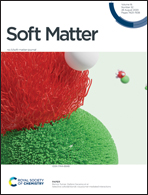Soft granular particles sheared at a controlled volume: rate-dependent dynamics and the solid–fluid transition
Abstract
We study the responses of fluid-immersed soft hydrogel spheres that are sheared under controlled volume fractions. Slippery, deformable particles along with the density-matched interstitial fluid are sandwiched between two opposing rough cones, allowing studies for a wide range of volume fraction ϕ both above and below the jamming of granular suspension. We utilize sudden cessations of shearing, accompanied by refraction-matched internal imaging, to supplement the conventional flow-curve measurements. At sufficiently high volume fractions, the settling of particles after the cessations exhibits a continuous yet distinct transition over the change of the shear rate. Such changes back out the qualitative difference in the state of flowing prior to the cessations: the quasi-static yielding of a tightly packed network, as opposed to the rapid sliding of particles mediated by the interstitial fluid whose dynamics depends on the driving rate. In addition, we determine the solid–fluid transition using two independent methods: the extrapolation of stress residues and the estimated yield stress from high values of ϕ, and the settling of particles upon shear cessations as ϕ goes across the transition. We also verify the power law on values of characteristic stress with respect to the distance from jamming ϕ − ϕc, with an exponent close to 2. These results demonstrate a multitude of relaxation timescales behind the dynamics of soft particles, and raise questions on how we extend the existing paradigms of the flow of a densely packed system when the softness is actively involved.



 Please wait while we load your content...
Please wait while we load your content...